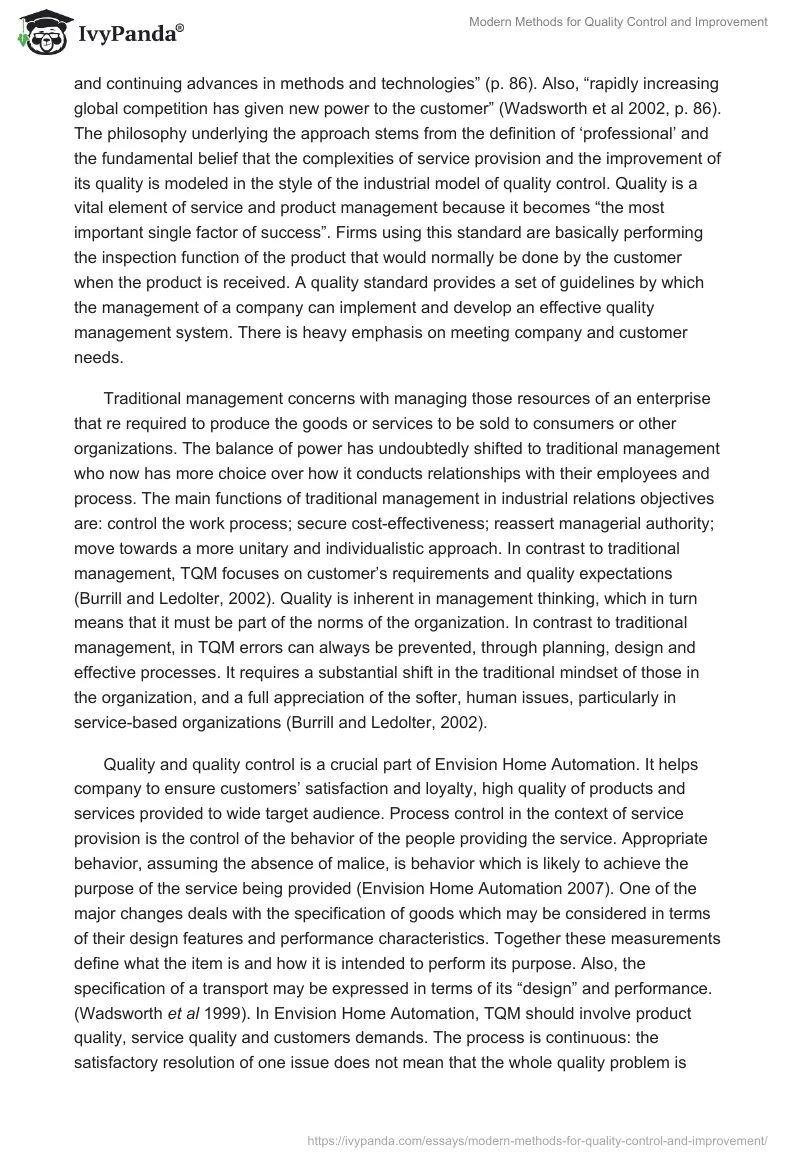The pursuit of quality in their products and services offers these institutions the opportunity to provide services comparable to those available in the private sector. There is nothing inherently ‘better’ about a privately owned and offered service than a public one. It is merely that the economic imperative for survival has traditionally been greater in the private sector. The management have the additional responsibility of considering the total effectiveness of the organization in terms of its use of all resources and the environmental implications of their actions.
Total quality management (TQM) is defined as a strategic approach to quality which permeates the entire organization. TQM is a top-down management philosophy that focuses on the needs of the customer. It comprises a quality plan which offers a structured, disciplined approach to quality and incorporates a number of tools and techniques. The main characteristics of TQM include a customer orientation, monitoring, finding and eliminating quality problems, effective audit and quality review. Wadsworth et al (2002) see TQM as “coordinated activities [aimed] to direct and control”.
Burrill and Ledolter (2004) emphasize the purposes of quality control (QC) and quality assurance (QA). All too often, the QC and QA functions in organizations become self-serving activities, focusing on apportioning blame and identifying guilty parties rather than on improving the performance of the organization. Burrill and Ledolter (2004) state that many of organizational efforts are wasted in error-based activity – for example, rework, rectification, inspection, and so on – and with an even higher proportion in service-based organizations. If quality can be achieved at the outset, rather than through detection and rectification, the total costs of the organization will always be reduced. For instance, “the ISO 9000 series places more emphasis on the structure and content of a quality management program as a part of the overall quality system” (Wadsworth et al 2002, p. 84).
Globalization has a great impact on quality decisions and control. Following Wadsworth et al (2002): “national and international quality system standards [are influenced by] the rapid globalization of trade, the increasing power of the customer, and continuing advances in methods and technologies” (p. 86). Also, “rapidly increasing global competition has given new power to the customer” (Wadsworth et al 2002, p. 86). The philosophy underlying the approach stems from the definition of ‘professional’ and the fundamental belief that the complexities of service provision and the improvement of its quality is modeled in the style of the industrial model of quality control. Quality is a vital element of service and product management because it becomes “the most important single factor of success”. Firms using this standard are basically performing the inspection function of the product that would normally be done by the customer when the product is received. A quality standard provides a set of guidelines by which the management of a company can implement and develop an effective quality management system. There is heavy emphasis on meeting company and customer needs.
Traditional management concerns with managing those resources of an enterprise that re required to produce the goods or services to be sold to consumers or other organizations. The balance of power has undoubtedly shifted to traditional management who now has more choice over how it conducts relationships with their employees and process. The main functions of traditional management in industrial relations objectives are: control the work process; secure cost-effectiveness; reassert managerial authority; move towards a more unitary and individualistic approach. In contrast to traditional management, TQM focuses on customer’s requirements and quality expectations (Burrill and Ledolter, 2002). Quality is inherent in management thinking, which in turn means that it must be part of the norms of the organization. In contrast to traditional management, in TQM errors can always be prevented, through planning, design and effective processes. It requires a substantial shift in the traditional mindset of those in the organization, and a full appreciation of the softer, human issues, particularly in service-based organizations (Burrill and Ledolter, 2002).
Quality and quality control is a crucial part of Envision Home Automation. It helps company to ensure customers’ satisfaction and loyalty, high quality of products and services provided to wide target audience. Process control in the context of service provision is the control of the behavior of the people providing the service. Appropriate behavior, assuming the absence of malice, is behavior which is likely to achieve the purpose of the service being provided (Envision Home Automation 2007). One of the major changes deals with the specification of goods which may be considered in terms of their design features and performance characteristics. Together these measurements define what the item is and how it is intended to perform its purpose. Also, the specification of a transport may be expressed in terms of its “design” and performance. (Wadsworth et al 1999). In Envision Home Automation, TQM should involve product quality, service quality and customers demands. The process is continuous: the satisfactory resolution of one issue does not mean that the whole quality problem is solved, it simply means that the organization has moved a step closer to being effective. As each gain is achieved and consolidated, so the primary issue continually changes, bringing the organization one step closer to the goal of zero defects or whatever other quality objective it has set itself. In order to achieve competitive advantage, Envision Home Automation should create value for their customers, select markets where they can excel and present a moving target to their competitors by continually improving their position. Three of the most important factors are innovation, quality and cost reduction.
References
- Burrill, C.W., Ledolter, J. (1999). Achieving Quality Through Continual Improvement. Wiley.
- Envision Home Automation (2007). Web.
- Wadsworth, H.M., Stephens, K.S., Godfrey, A.B. (2002) Modern Methods For Quality Control and Improvement, 2nd Edition. Wiley.


